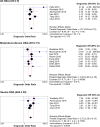Validation of the STOP-Bang questionnaire as a screening tool for obstructive sleep apnoea in patients with cardiovascular risk factors: a systematic review and meta-analysis
- PMID: 33664122
- PMCID: PMC7934717
- DOI: 10.1136/bmjresp-2020-000848
Validation of the STOP-Bang questionnaire as a screening tool for obstructive sleep apnoea in patients with cardiovascular risk factors: a systematic review and meta-analysis
Abstract
Introduction: Obstructive sleep apnoea (OSA) is highly prevalent in patients with cardiovascular risk factors and is associated with increased morbidity and mortality. This review presents the predictive parameters of the STOP-Bang questionnaire as a screening tool for OSA in this population.
Methods: A search of databases was performed. The inclusion criteria were: (1) use of the STOP-Bang questionnaire to screen for OSA in adults (>18 years) with cardiovascular risk factors; (2) polysomnography or home sleep apnoea testing performed as a reference standard; (3) OSA defined by either Apnoea-Hypopnoea Index (AHI) or Respiratory Disturbance Index; and (4) data on predictive parameters of the STOP-Bang questionnaire. A random-effects model was used to obtain pooled predictive parameters of the STOP-Bang questionnaire.
Results: The literature search resulted in 3888 articles, of which 9 papers met the inclusion criteria, involving 1894 patients. The average age of the included patients was 58±13 years with body mass index (BMI) of 30±6 kg/m2, and 64% were male. The STOP-Bang questionnaire has a sensitivity of 89.1%, 90.7% and 93.9% to screen for all (AHI ≥5), moderate-to-severe (AHI ≥15) and severe (AHI≥30) OSA, respectively. The specificity was 32.3%, 22.5% and 18.3% and the area under the curve (AUC) was 0.86, 0.65 and 0.52 for all, moderate-to-severe and severe OSA, respectively.
Conclusion: The STOP-Bang questionnaire is an effective tool to screen for OSA (AHI≥5) with AUC of 0.86 in patients with cardiovascular risk factors.
Keywords: sleep apnoea.
© Author(s) (or their employer(s)) 2021. Re-use permitted under CC BY-NC. No commercial re-use. See rights and permissions. Published by BMJ.
Conflict of interest statement
Competing interests: None declared.
Figures



Similar articles
-
Evaluation of the Arabic version of STOP-Bang questionnaire as a screening tool for obstructive sleep apnea.Sleep Breath. 2015 Dec;19(4):1235-40. doi: 10.1007/s11325-015-1150-x. Epub 2015 Mar 11. Sleep Breath. 2015. PMID: 25758298
-
The STOP-BANG questionnaire: reliability and validity of the Persian version in sleep clinic population.Qual Life Res. 2015 Aug;24(8):2025-30. doi: 10.1007/s11136-015-0923-9. Epub 2015 Jan 23. Qual Life Res. 2015. PMID: 25613199
-
Preoperative screening for obstructive sleep apnea in cardiovascular patients - How useful is STOP-BANG questionnaire in the Indian context?Ann Card Anaesth. 2021 Jul-Sep;24(3):308-312. doi: 10.4103/aca.ACA_132_20. Ann Card Anaesth. 2021. PMID: 34269259 Free PMC article.
-
Use and Performance of the STOP-Bang Questionnaire for Obstructive Sleep Apnea Screening Across Geographic Regions: A Systematic Review and Meta-Analysis.JAMA Netw Open. 2021 Mar 1;4(3):e211009. doi: 10.1001/jamanetworkopen.2021.1009. JAMA Netw Open. 2021. PMID: 33683333 Free PMC article.
-
Validation of the STOP-Bang questionnaire for screening of obstructive sleep apnea in the general population and commercial drivers: a systematic review and meta-analysis.Sleep Breath. 2021 Dec;25(4):1741-1751. doi: 10.1007/s11325-021-02299-y. Epub 2021 Jan 28. Sleep Breath. 2021. PMID: 33507478 Free PMC article.
Cited by
-
The association between sleep disturbances and tooth loss among post-stroke patients.Arq Neuropsiquiatr. 2022 Feb;80(2):173-179. doi: 10.1590/0004-282X-ANP-2020-0368. Arq Neuropsiquiatr. 2022. PMID: 35352755 Free PMC article.
-
STOP-Bang Score and Prediction of Severity of Obstructive Sleep Apnea in a First Nation Community in Saskatchewan, Canada.Clocks Sleep. 2022 Oct 12;4(4):535-548. doi: 10.3390/clockssleep4040042. Clocks Sleep. 2022. PMID: 36278535 Free PMC article.
-
The value of nurse-led anthropometric and oropharyngeal measurements combined with STOP-Bang questionnaire in screening for obstructive sleep apnea in patients with acute coronary syndrome: a prospective cohort study.BMC Pulm Med. 2022 Nov 3;22(1):396. doi: 10.1186/s12890-022-02200-x. BMC Pulm Med. 2022. PMID: 36329414 Free PMC article.
-
The usefulness of the Spanish version of the STOP-Bang questionnaire for screening for moderate or severe sleep apnea syndrome in primary care.Front Public Health. 2022 Sep 9;10:975114. doi: 10.3389/fpubh.2022.975114. eCollection 2022. Front Public Health. 2022. PMID: 36159274 Free PMC article.
-
Insights into the Use of Point-of-Care Ultrasound for Diagnosing Obstructive Sleep Apnea.Diagnostics (Basel). 2023 Jul 4;13(13):2262. doi: 10.3390/diagnostics13132262. Diagnostics (Basel). 2023. PMID: 37443656 Free PMC article. Review.
References
Publication types
MeSH terms
LinkOut - more resources
Full Text Sources
Other Literature Sources
Miscellaneous
